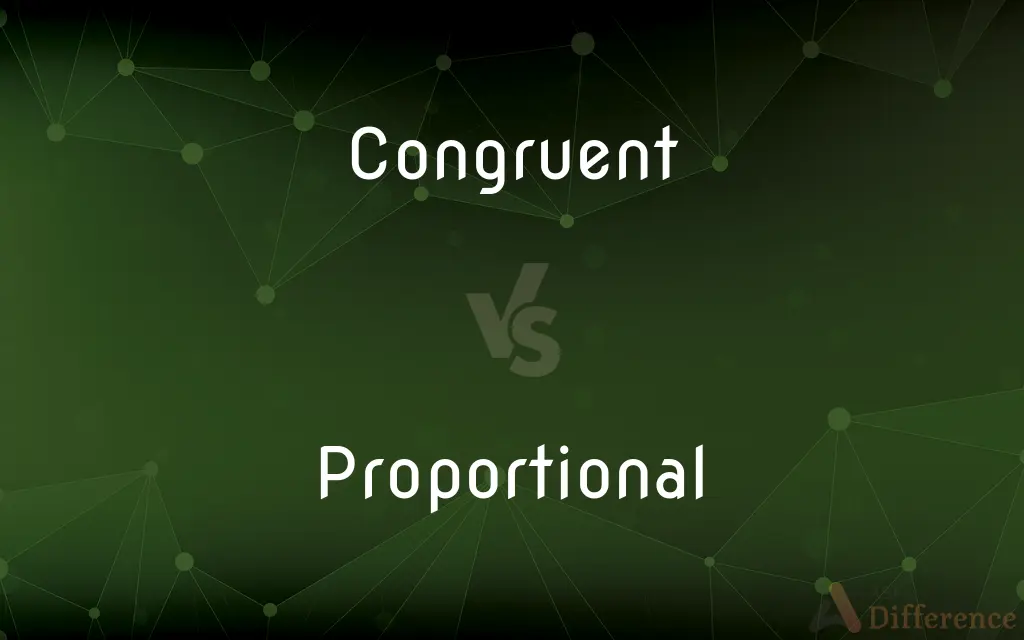Congruent vs. Proportional — What's the Difference?
Edited by Tayyaba Rehman — By Urooj Arif — Updated on April 4, 2024
Congruent figures have the same shape and size, while proportional ones share a common ratio but differ in size.

Difference Between Congruent and Proportional
Table of Contents
ADVERTISEMENT
Key Differences
Congruent figures and proportional figures are both fundamental concepts in geometry, but they cater to different aspects of shape analysis. Congruence deals with exact sameness in shape and size, where every angle and side of one figure is identical to those of another. This exactness is crucial in various applications, like determining if two objects will fit together perfectly without any gaps or overlaps. On the other hand, proportionality speaks to a relationship of similarity where figures or quantities have the same shape but different sizes, scaled up or down by a common ratio. This concept is pivotal in understanding and applying scale factors, such as in model building, map reading, and resizing images while maintaining the aspect ratio.
Congruent figures are often denoted by markings on diagrams to show pairs of equal angles and equal sides, making it clear that two or more figures are congruent. This visualization helps in geometric proofs and solving problems where precise shape duplication is required. Whereas, proportional figures might not bear such markings since their sides and angles are not exactly the same; they are scaled versions of each other. Here, calculations often involve finding the scale factor or using ratios to compare corresponding sides or angles.
In terms of transformations, congruent figures can be obtained through rigid motions: translations, rotations, and reflections. These transformations do not alter the size or shape of the object, hence preserving congruency. Proportional figures, conversely, involve dilations or scaling, where figures are enlarged or reduced while keeping their shape consistent. This distinction highlights the inherent nature of congruence as preserving exactness, whereas proportionality allows for size variability.
Moreover, congruence is a more stringent requirement than proportionality. For two figures to be congruent, they must match in every geometric aspect, making congruence a special case of similarity (a broader term that includes both congruence and proportionality). Proportionality allows for more flexibility in applications since it only requires figures to maintain a consistent shape ratio, enabling a wider range of comparisons and transformations.
While congruent figures are identical in every way, making them interchangeable in many geometric scenarios, proportional figures offer a degree of scalability that is essential in real-world applications like architecture and design, where maintaining the integrity of designs at various scales is crucial. This distinction underlines the unique roles these concepts play in both theoretical and practical mathematics.
ADVERTISEMENT
Comparison Chart
Definition
Exact match in shape and size
Similar shape, different size but constant ratio
Markings
Uses markings to denote equal angles and sides
No specific markings, focuses on scale factor
Transformations
Involves rigid motions (translations, rotations, reflections)
Involves dilations or scaling
Requirement
Stringent, requiring exact duplication
Flexible, requires maintaining a shape ratio
Application
Geometric proofs, fitting objects together perfectly
Model building, resizing images, map reading
Compare with Definitions
Congruent
Identical in form and size.
Two congruent triangles can be perfectly overlapped without any gaps.
Proportional
Involved in scale transformations.
A proportional scale model is a smaller or larger representation of an object, keeping proportions intact.
Congruent
Reflects exact duplication in geometry.
Congruent shapes are used in tiling patterns for seamless coverage.
Proportional
Essential for similarity in geometric shapes.
Proportional triangles are similar, sharing angles but differing in side lengths.
Congruent
Found through rigid motions without altering size or shape.
A reflection across a line can produce two congruent figures.
Proportional
Used in practical applications like map reading.
Maps are proportional representations of geographical areas.
Congruent
Requires all corresponding angles and sides to be equal.
Congruent polygons are the cornerstone of symmetry studies.
Proportional
Maintains a constant ratio despite different sizes.
Proportional rectangles may differ in size but have the same aspect ratio.
Congruent
Determined by specific congruence criteria like SSS, SAS, etc.
Congruent figures are often proven with the ASA criterion in geometry.
Proportional
Depends on the concept of scale factor.
A sculpture might be enlarged by a proportional scale factor to create a dramatic public display.
Congruent
Corresponding; congruous.
Proportional
Forming a relationship with other parts or quantities; being in proportion.
Congruent
Coinciding exactly when superimposed
Congruent triangles.
Proportional
Properly related in size, degree, or other measurable characteristics; corresponding
Punishment ought to be proportional to the crime.
Congruent
Of or relating to two numbers that have the same remainder when divided by a third number. For example, 11 and 26 are congruent when the modulus is 5.
Proportional
(Mathematics) Having the same or a constant ratio.
Congruent
Corresponding in character; congruous
Proportional
One of the quantities in a mathematical proportion.
Congruent
Harmonious.
Proportional
(mathematics) At a constant ratio (to). Two magnitudes (numbers) are said to be proportional if the second varies in a direct relation arithmetically to the first. Symbol: ∝.
Congruent
(mathematics) Having a difference divisible by a modulus.
Proportional
In proportion (to), proportionate.
Congruent
(mathematics) Coinciding exactly when superimposed.
Proportional
Of a typeface, having characters with natural (non-uniform) width (in contrast to monospace typefaces).
Congruent
(algebra) Satisfying a congruence relation.
Proportional
A proportion.
Congruent
Possessing congruity; suitable; agreeing; corresponding.
The congruent and harmonious fitting of parts in a sentence.
Proportional
Having a due proportion, or comparative relation; being in suitable proportion or degree; as, the parts of an edifice are proportional.
Congruent
Corresponding in character or kind
Proportional
Relating to, or securing, proportion.
Congruent
Coinciding when superimposed
Proportional
Constituting a proportion; having the same, or a constant, ratio; as, proportional quantities; momentum is proportional to quantity of matter.
Proportional
Any number or quantity in a proportion; as, a mean proportional.
Proportional
The combining weight or equivalent of an element.
Proportional
One of the quantities in a mathematical proportion
Proportional
Properly related in size or degree or other measurable characteristics; usually followed by `to';
Punishment oughtt to be proportional to the crime
Earnings relative to production
Proportional
Increasing as the amount taxed increases
Common Curiosities
How is proportionality useful in real life?
Proportionality is crucial in scaling models, architecture, and ensuring that designs maintain their integrity at different sizes.
What is the difference between congruent and similar figures?
Congruent figures are identical in every aspect, while similar figures have the same shape but may differ in size.
How are proportional figures identified?
Proportional figures maintain the same shape but have different sizes, identifiable by a constant ratio or scale factor between them.
Can congruent figures be rotated or flipped?
Yes, congruent figures can undergo rotations, reflections, or translations and remain congruent.
What is a common use of congruent figures in mathematics?
Congruent figures are often used in geometric proofs and constructing objects with precise dimensions.
How do you calculate the scale factor for proportional figures?
The scale factor is calculated by dividing the lengths of corresponding sides of proportional figures.
What transformations lead to congruent figures?
Rigid motions, including translations, rotations, and reflections, lead to congruent figures.
Can congruence be applied to non-geometric contexts?
While primarily a geometric concept, congruence can metaphorically refer to agreement or harmony in non-geometric contexts.
What distinguishes proportional figures from congruent ones in terms of angles?
Proportional figures have angles that are equal, similar to congruent figures, but their sides are scaled differently.
Is it possible for a figure to be both congruent and proportional to another?
If two figures are congruent, they are automatically proportional with a scale factor of 1, but not all proportional figures are congruent.
What role does proportionality play in map making?
Proportionality allows for accurate scaling of geographical features on maps, maintaining correct ratios.
What makes two figures congruent?
Two figures are congruent if they have the exact same shape and size, with all corresponding angles and sides equal.
Why are congruent figures important in geometry?
Congruence ensures that figures can fit together perfectly, essential for tiling, symmetry, and geometric constructions.
How do congruent and proportional figures differ in their use in design?
Congruent figures ensure uniformity and precise fit in designs, while proportional figures allow for scalable designs maintaining aesthetic ratios.
How do dilations affect the congruence of figures?
Dilations change the size of figures, thus making them non-congruent but can result in proportional figures.
Share Your Discovery

Previous Comparison
Reproduction vs. Procreation
Next Comparison
Gall vs. NerveAuthor Spotlight
Written by
Urooj ArifUrooj is a skilled content writer at Ask Difference, known for her exceptional ability to simplify complex topics into engaging and informative content. With a passion for research and a flair for clear, concise writing, she consistently delivers articles that resonate with our diverse audience.
Edited by
Tayyaba RehmanTayyaba Rehman is a distinguished writer, currently serving as a primary contributor to askdifference.com. As a researcher in semantics and etymology, Tayyaba's passion for the complexity of languages and their distinctions has found a perfect home on the platform. Tayyaba delves into the intricacies of language, distinguishing between commonly confused words and phrases, thereby providing clarity for readers worldwide.














































